Col. Sudhir Farm
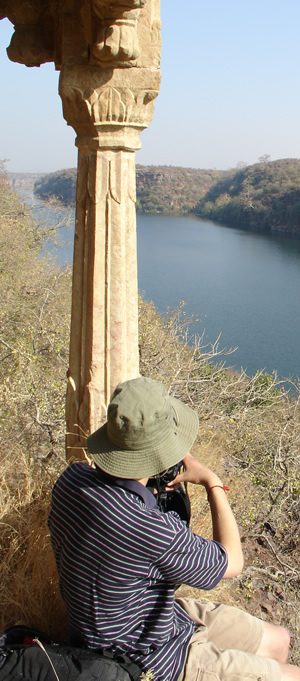
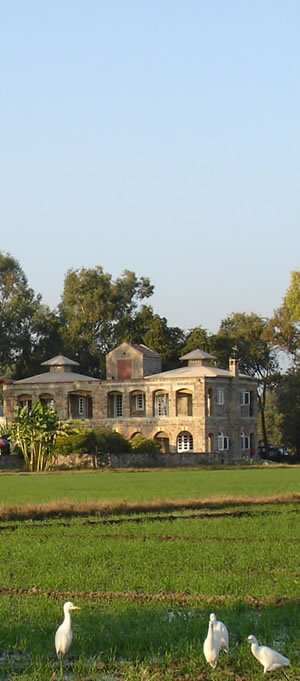
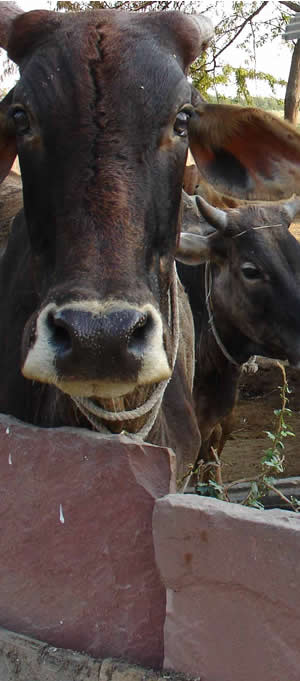
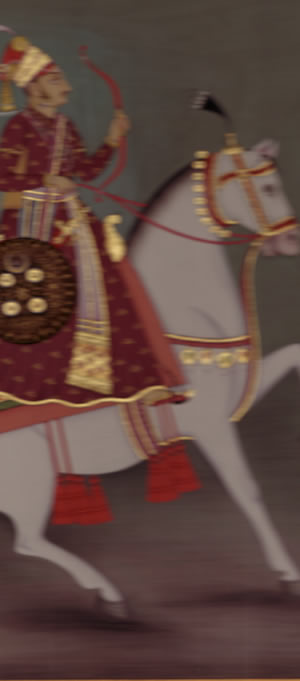
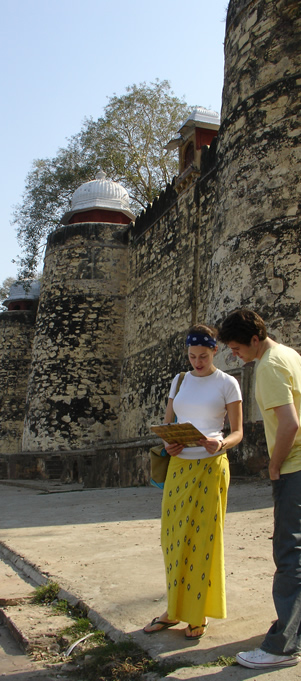
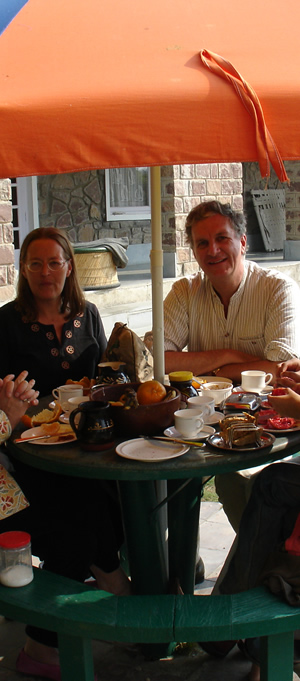
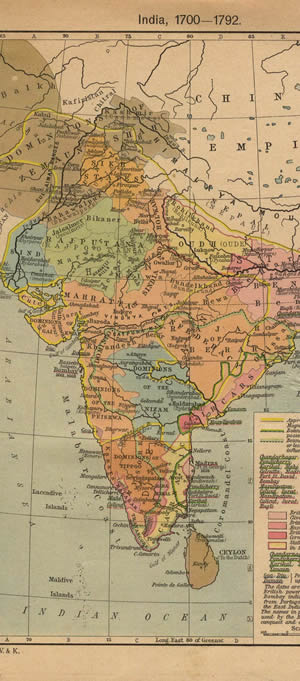
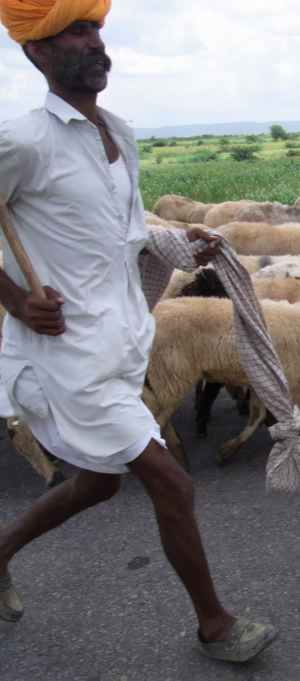
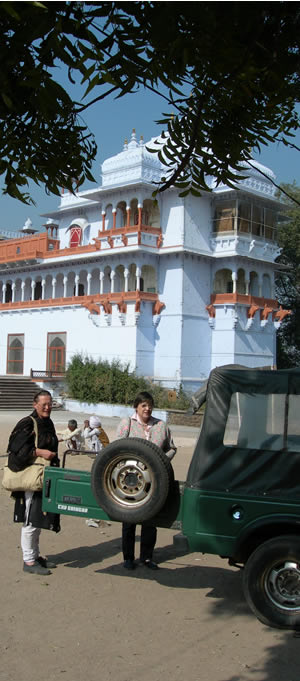
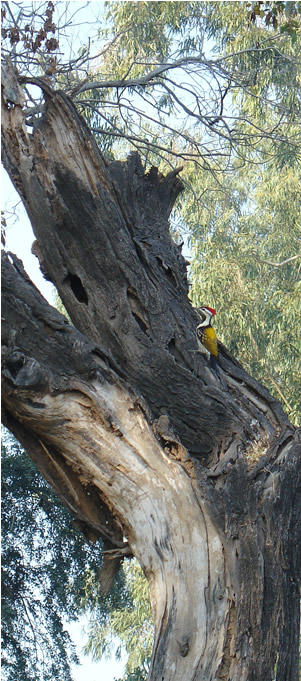
Snippets from the Visitors' Book
The Kota tonga trail was a real highlight - a bit like a 19th Century treasure hunt. It’s full of little nuggets of unusual information and fascinating glimpses into the unsolved mysteries of Kota.
Harriet and Will, London. UK
The memorial to Major Burton and his sons was much more moving than the Taj Mahal or the lake at Udaipur, marvellous as they are.
Henry Vane, Cumbria, UK
...the most comfortable bed I’ve slept in for 2 months....
Charlotte Adam, Winchester UK
Two days out of the noise and the people in a beautiful place. We felt totally
at home
- To be recommended to every person who wishes to experience the Indian country life. We also liked the way the food was prepared...
Patrick & Marie-Christine Lemaigre, Nil-St Vincent, Belgium
We’re only here for the porridge and home made bread! Thank you for a most wonderful time the memories of which we shall carry always. You have given us a wonderful & fascinating introduction to India.
Sue Turner, Lancashire, UK
So ...Rajasthan is not all desert! Thank you for sharing everything with us....
The Read family, London, UK
What a wonderful time we’ve had at the school in the village, at the weavers’, on the river, atop a tonga! Thank you for all your help and contacts throughout India
Anne Gerbner, Philadelphia, USA
It was a wonderful stay and thank you for giving us such a positive look at India and Rajasthan.
Salma Goldstein, New Jersey, USA
- There once was a lady of Kota
- Who took visitors out in her motor
- With the roads and the ruts
- It took quite some guts
- To go out with the lady of Kota.
- But once back at home on the farm
- The world quite descended to calm
- With the plants and the birds
- And fox terriers in herds
- There was balm in the calm on the farm.
Sue Millar, London, UK
After travelling around Rajasthan for two weeks, reaching a real house with books on the shelves, photos on the walls and four happy dogs was simply wonderful.
Camille Savinien, Paris, France
This isn’t tourism. I know of nowhere else where you can experience the real India as well as on your traditional working Rajasthani farm.
Sam Milward, Wellington, New Zealand
Thank you so very much for such a wonderful stay - what a fantastic introduction to India. I don’t think we’ll find such tranquillity elsewhere.
Lizzie Fortune, Hampshire. UK
Fabulous - I’ve been spoilt. It’s hard to leave and face the real world.
Elisabeth Simson, Isle of Wight, UK
After travelling around Rajasthan for two weeks, reaching a real house with books on the shelves, photos on the walls and four happy dogs was simply wonderful.
Camille Savinien, Paris, France
This isn’t tourism. I know of nowhere else where you can experience the real India as well as on your traditional working Rajasthani farm.
Sam Milward, Wellington, New Zealand
Thank you so very much for such a wonderful stay - what a fantastic introduction to India. I don’t think we’ll find such tranquillity elsewhere.
Lizzie Fortune, Hampshire. UK
Our visit at the farm was truly wonderful, off the beaten track it is a slice of India a visitor does not normally experience. Victoria is very knowledgeable about Indian culture and the people - an added perspective for us. The food here was very delicious: organically home grown ingredients, vegetables, fruits, grains prepared simply homestyle. A nice change from curries. Enjoyed the early morning boat ride and walk to the weavers. Many thanks.
Johanna Janssens, Washington, USA
I loved staying with you and the dogs and playing with the toys.
Jonas aged 8, Switzerland
A very welcome break from the crazy world of India – wonderful house, food and hospitality. Thank you so much.
Katie Buxton, Bath, UK
I loved seeing the crocodiles, and I learned a lot about deticking the puppies. Coming to the farm was a great experience.
Stella Bartholet, Washington, USA
A wonderful eye opening visit in every sense. We will be back! Thank you!
Christopher & Joanna Hobson, Northamptonshire, UK
A blissfully peaceful stay. We enjoyed everything – even the power cut. Thank you for lovely food, good company and very interesting trips.
Vicky Stark, London, UK
Exactly what we hoped for and more, bits of India off the tourist track, life as it actually is in villages, teeming life and livestock and the magic of the river.
Sir Hilary Miller, Worcester, UK
Thank you for the introduction to miniature painters, wall paintings, stories, great food, good company, walk through the fields. I loved the paintings in the City Palace and go back full of inspiration and memories.
Nan Mulder, Edinburgh, UK

On the Farm - 2016 Archive
On the Farm - December ’16
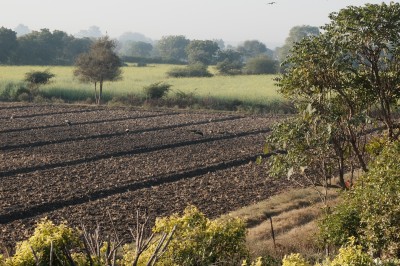
The problems caused by demonetisation have continued all month. Our men have not been able to withdraw money from their banks because of long queues and the necessity to get back to work rather than bide their time outside their bank.
They have been busy pre-watering the wheat fields. Sowing started on 10th December. Here the peacocks are looking for rice, which was the previous crop, in a field that has just been sown with wheat. At night the wild pigs came rooting for the freshly planted wheat. In the background you can see flowering mustard.
As all the fields became out-of-bounds for the cows, they were confiined to their yard and had to live on dry rice straw until the green fodder called bersim was ready.
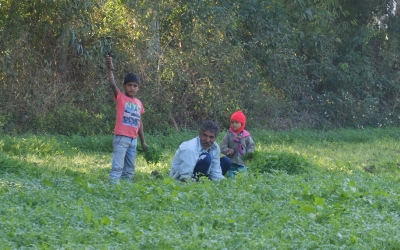
You are never too young to help on a farm. Here three year old Ritu has a sickle and is helping cut bersim for the cows, while her brother Dashrath strikes a very yesteryear Soviet poster pose with his sickle.
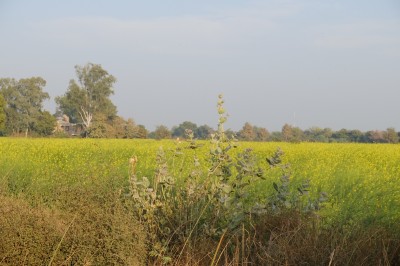
By the end of December, every field was planted with either wheat or mustard but the mustard was past its best and the fluorescent yellow view was beginning to fade.
On the Farm - November ’16
The big story in November was the completely unexpected announcement on the 8th that Rs. 500 and Rs. 1000 currency notes would no longer be legal tender after midnight. It was estimated that 85% of currency by value was in higher denomination notes. The cash economy came to a halt overnight and our farm hands and house-maid have had to accept part of their salary in their new bank accounts rather than cash in hand. Unfortunately, there were long queues at the banks to withdraw cash and there was a daily maximum withdrawal limit of Rs. 2000 as a single note for the special Jan Dhan accounts for the not so well off. The equivalent for them of a GBP 50 note i.e. 1/3 of their salary. In time this situation will ease but the agricultural sector which operated mainly in cash has had to change overnight. The hope is that tax compliance will become the norm as tax evasion in being made so expensive and the poor will benefit in the long run.
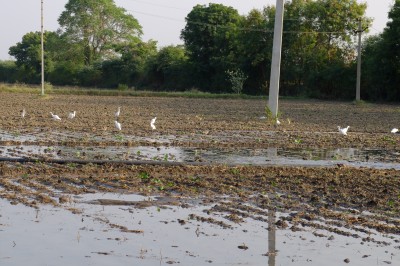
On the farm the month started with watering the mustard early in the hope that more seeds would germinate as germination had been poor. In some fields extra seed was broadcast and these fields were saved. In one other field it was hoped that previously sown seed would germinate after watering, and when this did not happen the field was ploughed-in and wheat sown.
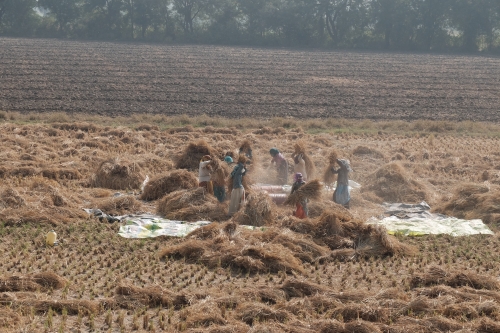
Eleven women started harvesting the rice on 9th November and finished on the 20th. Here they are bashing each tied bundle to get the grain out.
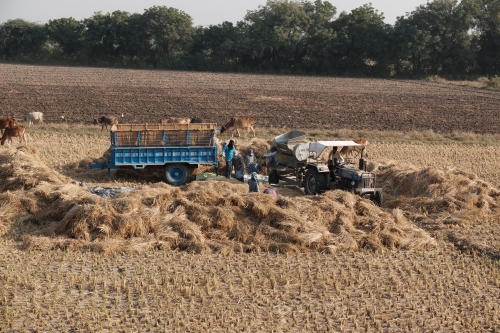
Here is the final process of threshing by machine. Although the crop looked abundant the yield was down by 1/3 as 1/3 of plants had dried-out without producing grain. The price was also 2/3 of what we got 3 years ago.
The soyabean crop was poor having been damaged by pigs so there was very little chaff for the cows. They will be living on rice straw.
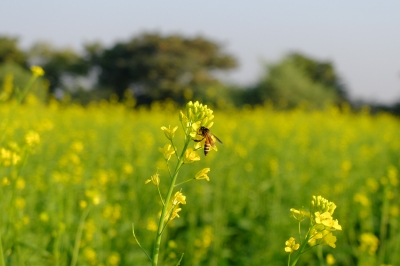
By the end of the month the mustard was flowering and the rock bees - apis dorsata - appeared. We have not spotted their hives yet and have not spotted any little bees - apis florea - which are normally in the mustard.
On the Farm - October ’16
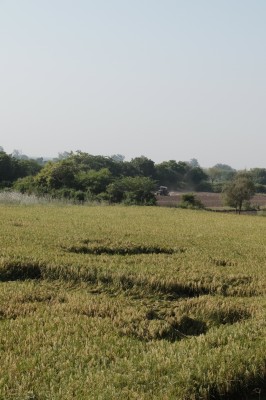
After little rain in September we received 21/4 inches in the first few days of October. The accompanying winds created this crop circle effect. Although the rice looked healthy it had caught a disease that caused some stalks to dry out and for the husks to remain empty. The next door farm sprayed but we didn’t. One estimate is 50% loss. The tractor in the background is preparing the field for mustard.
Instead of the usual DAP we planted mustard on 14th with superphosphate and a bio-fertiliser called VAM which is supposed to promote root growth.
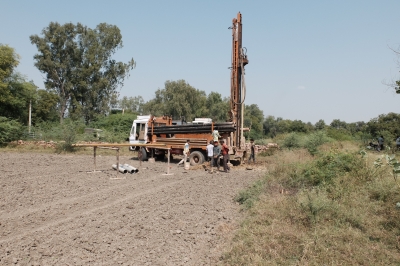
These two lorries plus a team of men came to drill a borewell on land sold by us. The owner says he is either building a branch of his school or a sports ground. He chose the location for drilling according to Vastu Shastra principles which dictate that water source should be to the north-east. Unfortunately for him this wasn’t in sync with the underlying geology and they drilled to 320 feet and found only a small amount of water. Our borewell locations had been chosen by a water diviner who claimed to be able to hear water underground and smell the earth for water and our borings are 150 feet. Is it just luck?
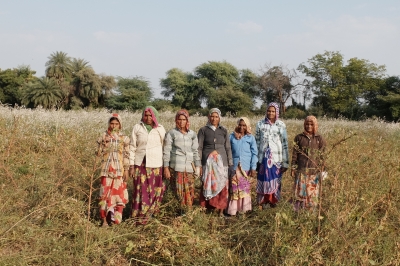
Here is the soyabean cutting team in a field of some soyabean and much very tall weed which had to be cut separately after the harvest. We had not been able to weed at the right time because of the sodden conditions.
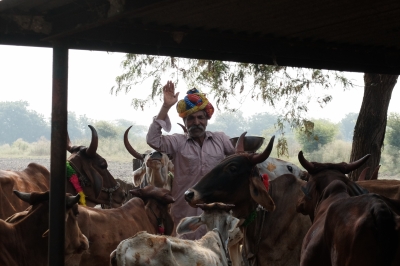
October ended with Diwali and a rare visit from our son. He was able to watch the Govardhan Pooja, which honours the cows, for the first time ever. He had never been home in October for twenty years. Mewa Lal is fending off eager decorated cows as he feeds them sweetened puris.
On the Farm - September ’16
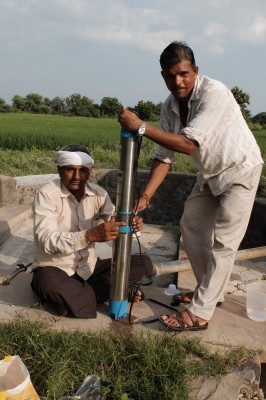
After August’s downpours the monsoon ended early and there was no more rain after 3rd September which meant that we had to water the soyabean and keep watering the rice.
Disaster struck on 10th September as a fault developed in the transformer so it could not run a 3-phase motor. We bought and fitted a single phase motor in the interim or we would have had no water in the house. One electrical fault led to another and it was not until 21st that the original system was working again.
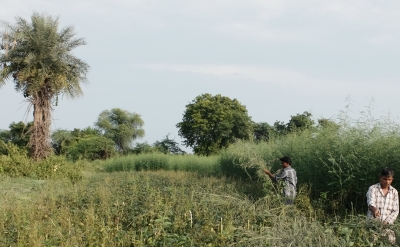
Meanwhile, a previous year’s sowing of 'dhaincha' for green manure had re-sprouted shading the soyabean and helping to suck up surplus rain water. On 16th we begain cutting this forest of weeds in the hope that the soyabeans beneath would set and swell.
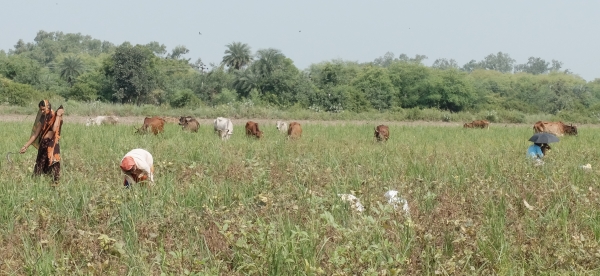
We are hoping for some income from the rice and soyabean but our experimental crop of urad lentils was a complete loss and not worth the harvesting expense. Women were invited to pick the pods and thresh them on a 50:50 basis. Here they are searching for pods before the cattle trample on them. The man in charge of the cattle is under the black umbrella with 3-year old Ritu whose mother is gleaning. Urad lentil sells for about Rs.150 per kg. Our share at the end of the process was about 20 kgs. We should have earned over Rs.200,000!
On the Farm - August ’16
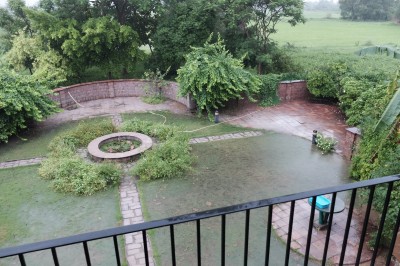
The main feature of August has been rain. 60.5 cms approximately which is nearly 24". 26 cms of that fell on 7th and 8th August leaving all crops standing in water. Only the rice was happy. Here you can see the garden disappearing under water and the blue washing up bowl, that serves as a rain gauge, filling up.
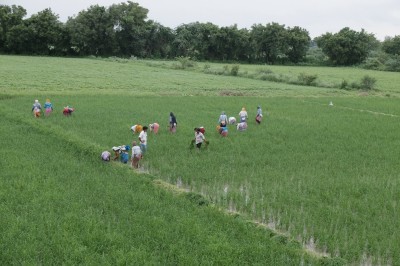
The rice was hand weeded at the beginning of the month. The women kept working despite torrential showers. The men carried the clumps of weed to the 'bunds' or little dams, as it is hard to move when you are standing barefoot in mud. The women earned Rs.150 a day for this work, roughly GBP 1.80.
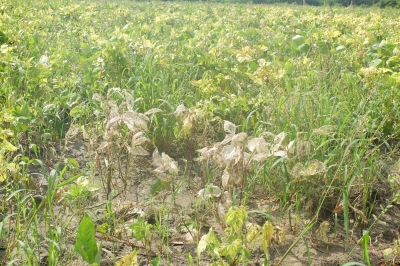
Traditional rainfed crops of this area are soyabean and dals. We have 36 bighas of urad this year as an experiment. There is a huge shortfall of dal/lentils in India and the Government is importing from Myanmar and other countries at higher prices than it is prepared to give Indian farmers.
This is what our urad looked like by the end of the month. The plants that have not died have gone yellow and have very few pods. It was too wet to weed so the grass has had a 'field day'. A big loss. The soyabean has fared little better depending on for how long it was standing in water.
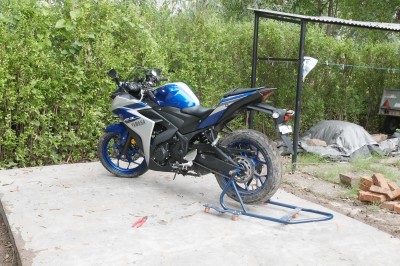
The other big news of August is the arrival of new family member, this Yamaha R3, the first in Kota! It is sitting on the concrete base that will become a shed in September or October.
On the Farm - July ’16
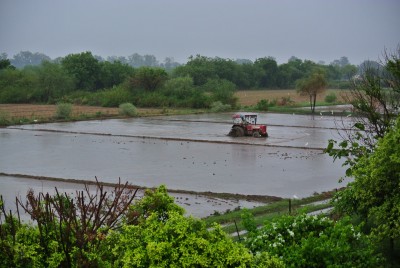
Showers and thunderstorms have brought relief in July with hot, humid conditions in between. We have planted urad (a lentil), soyabean, rice and a green manure hemp family plant called sann, or commonly referred to as sunbeeja. We also planted one bigha (17424 sq. ft.) of tulsi experimentally, which is like basil and very important medicinally, but it did not germinate because of heavy rains immediately after the tiny black seeds had been broadcast. The farm went from brown to lush green over the month.
These rice fields have been flooded and the tractor is puddling them. This softens the soil for transplanting the rice and helps in reducing percolation losses of water and controls the weeds.
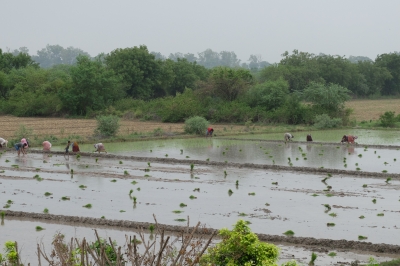
The rice seeds have been prepared in a separate nursery and now a team of women stand in the soft mud all day in bare feet and thrust the young plants into the mud. The expert men from Bihar have not appeared this year but some local women are willing to be bent over all day for about 2 GBP. You can see that the fields in the background look bare, but they have been planted with soya bean.
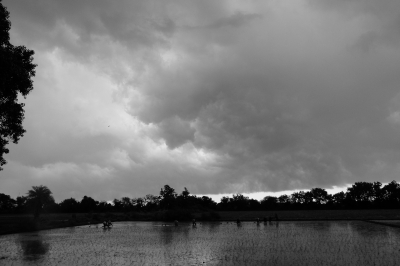
After months of clear skies, monsoon clouds are very dramatic. Here this monsoon rice planting scene has been captured in black and white.
Total rain for July was approximately 30 cms. or 12 inches.
On the Farm - June ’16
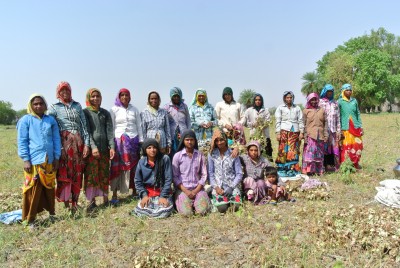 The moong was harvested in early June. Here are the seventeen women who came each day to cut it. The little girl just had to amuse herself in the shade as best she could. Mostly she just sat.
The moong was harvested in early June. Here are the seventeen women who came each day to cut it. The little girl just had to amuse herself in the shade as best she could. Mostly she just sat.
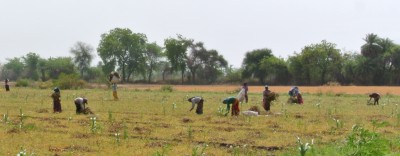 After the moong had been cut and put in small piles to dry, it was collected into one big pile for threshing.
After the moong had been cut and put in small piles to dry, it was collected into one big pile for threshing.
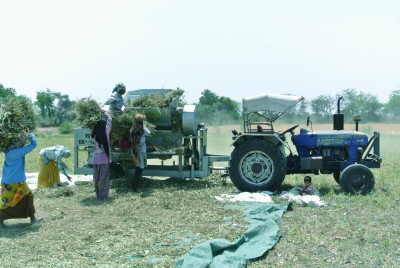 The women threshed and the little girl sat by the tractor. The sacks are stored in the house waiting for the price to go up.
The women threshed and the little girl sat by the tractor. The sacks are stored in the house waiting for the price to go up.
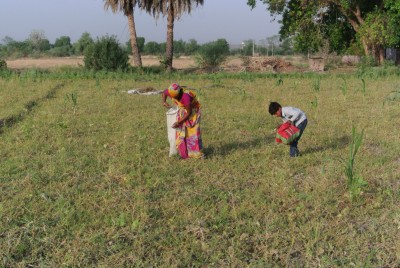 After the threshing we allocated different fields to the women on our farm and they gleaned moong pods for their home consumption. It was a lot of work in great heat, so they did it in the early morning as here, or in the evening. Daily temperatures were well over 40oC.
After the threshing we allocated different fields to the women on our farm and they gleaned moong pods for their home consumption. It was a lot of work in great heat, so they did it in the early morning as here, or in the evening. Daily temperatures were well over 40oC.
The rest of June was devoted to ploughing, clearing undergrowth, chopping up trees blown down in storms and general maintenance.
On the Farm - May ’16
After the wheat harvest, attention turned to our organic moong which as a green oasis in a barren landscape was attracting nightly visits by nilgai (blue bull) and stray cattle.
The moong (mung) had been sown on March 23rd and was watered in April and sprayed with an organic compound to stimulate root growth. Two men slept by the crop in shifts inside a mosquito net to scare away marauding animals. The dogs sat with them in the nighttime temperatures of 35oC+ and helped. Daytime temperatures in May reached 47oC after a long time, but still people were prepared to work as weeders.
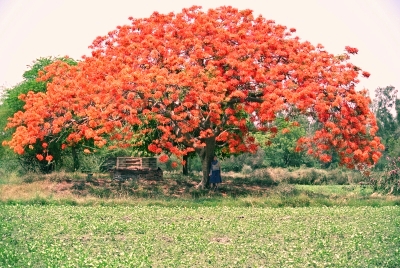 Here the gul mohar tree is slightly past its best. The green plants in front and to the side are moong.
Here the gul mohar tree is slightly past its best. The green plants in front and to the side are moong.
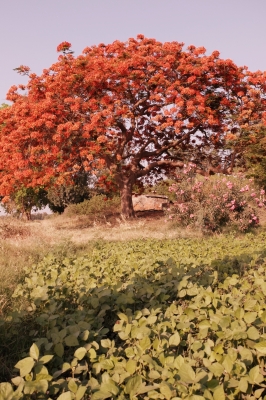 Here you can see the plants in more detail just before flowering and pod setting.
Here you can see the plants in more detail just before flowering and pod setting.
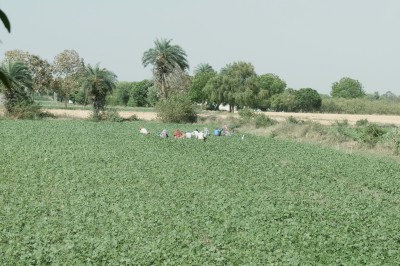 We weeded one field but not the other as it was so expensive. Even though each woman earned the equivalent of 1.60 GBP a day. On 31st May the moong was handcut and left to dry in bundles.
We weeded one field but not the other as it was so expensive. Even though each woman earned the equivalent of 1.60 GBP a day. On 31st May the moong was handcut and left to dry in bundles.
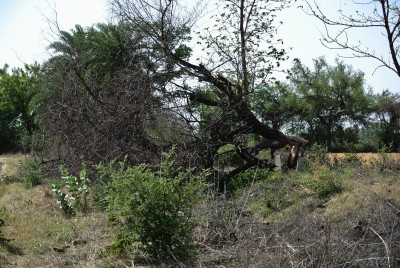 May had one or two significant storms this year and several mature trees blew down. This 'ber' tree has a wild berry rather like sweet crab apple much beloved by wild pigs, jackals and children. You can see the dog tombstones which it has sheltered. Over the years at least six dogs and twelve puppies have been buried there but only the original two wire-haired fox-terriers we brought out with us twenty years ago have engraved gravestones.
May had one or two significant storms this year and several mature trees blew down. This 'ber' tree has a wild berry rather like sweet crab apple much beloved by wild pigs, jackals and children. You can see the dog tombstones which it has sheltered. Over the years at least six dogs and twelve puppies have been buried there but only the original two wire-haired fox-terriers we brought out with us twenty years ago have engraved gravestones.
On the Farm - April ’16
April is the busiest month of the year and this year there were no untoward hail storms or bad weather. It did not rain once.
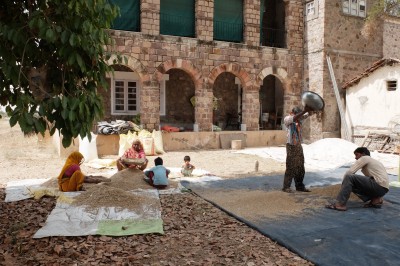 The coriander was hand-cut and had to be winnowed to fetch a higher price. After cutting, a lot of shrubby weed was left in the field which had to be cut and burned as we had not weeded the crop.
The coriander was hand-cut and had to be winnowed to fetch a higher price. After cutting, a lot of shrubby weed was left in the field which had to be cut and burned as we had not weeded the crop.
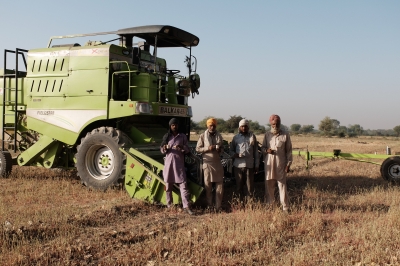 Some wheat was cut by machine and here is the team from the Punjab who camped here for a night. They gradually move North back to the Punjab where the harvest is later.
Some wheat was cut by machine and here is the team from the Punjab who camped here for a night. They gradually move North back to the Punjab where the harvest is later.
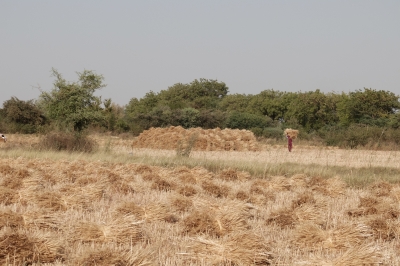 Some wheat was cut by hand by two families from Madhya Pradesh. The men came round the farms to get work and fix rates and then they went back home and fetched their families and camped in the open for two weeks. These field have always been cut by combine before but the 'bhoussa' or chaff is so valuable as cattle fodder in a drought year that it made sense to hand-cut it. When the wheat is combined a lot of the straw is left standing in the field. We did not want to burn it and applied a bespoke 'SPEED COMPOST' liquid mixture later on to quicken decomposition after a rotavator had been through the fields.
Some wheat was cut by hand by two families from Madhya Pradesh. The men came round the farms to get work and fix rates and then they went back home and fetched their families and camped in the open for two weeks. These field have always been cut by combine before but the 'bhoussa' or chaff is so valuable as cattle fodder in a drought year that it made sense to hand-cut it. When the wheat is combined a lot of the straw is left standing in the field. We did not want to burn it and applied a bespoke 'SPEED COMPOST' liquid mixture later on to quicken decomposition after a rotavator had been through the fields.
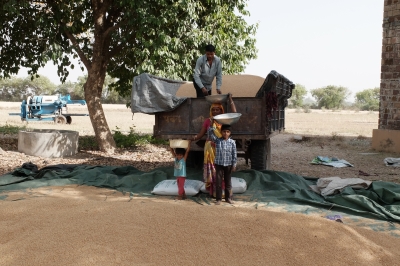 Each trolley is filled by hand and the children enjoy helping.
Each trolley is filled by hand and the children enjoy helping.
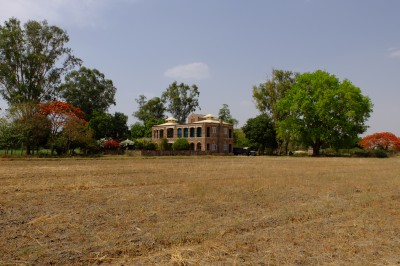 After the harvest the red flowering gul mohar tree and pink and white bougainvillea bushes provide dramatic patches of colour.
After the harvest the red flowering gul mohar tree and pink and white bougainvillea bushes provide dramatic patches of colour.
On the Farm - March ’16
At the beginning of March it was 12oC at night and by the end it was 20oC. No rain so the crops ripened well and the mustard and coriander were harvested without the devasting loss caused by hail stones that Northern India suffered last year.
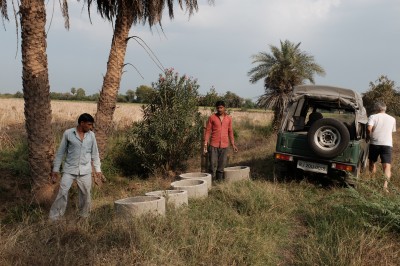 We dug holes and had five cement rings made to protect young mahua trees (Madhuca longifolia var. latifolia) that we had grown from seed. Here the cement rings have been unloaded from the Gypsy. We put wooden posts and green netting to protect them from the sun and wild animals. They have to be watered every other day if they are to survive. Mahua is a beautiful deciduous tree with white fragrant flowers and red olive shaped fruit that ferment after falling causing wild pigs to stagger.
We dug holes and had five cement rings made to protect young mahua trees (Madhuca longifolia var. latifolia) that we had grown from seed. Here the cement rings have been unloaded from the Gypsy. We put wooden posts and green netting to protect them from the sun and wild animals. They have to be watered every other day if they are to survive. Mahua is a beautiful deciduous tree with white fragrant flowers and red olive shaped fruit that ferment after falling causing wild pigs to stagger.
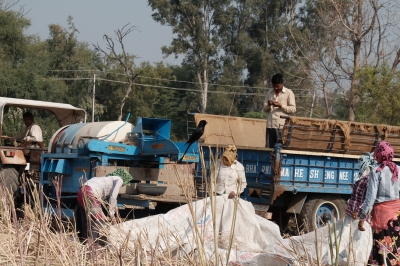 Mustard threshing started on 8th March. Two separate small teams of women cut the mustard. The teams get smaller each year. Here is one team working at the thresher watched by the tractor driver - male, the trolley filler - male, and maybe the watchful drongo is male too.
Mustard threshing started on 8th March. Two separate small teams of women cut the mustard. The teams get smaller each year. Here is one team working at the thresher watched by the tractor driver - male, the trolley filler - male, and maybe the watchful drongo is male too.
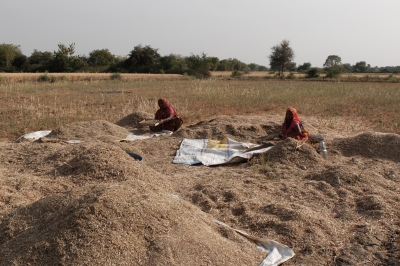 The coriander was also cut and threshed but a lot of seeds ended up in the waste pile so Sita and Avanta Bai set-to to sieve the seeds out. They are working on a 50:50 basis and will probably do well out of it.
The coriander was also cut and threshed but a lot of seeds ended up in the waste pile so Sita and Avanta Bai set-to to sieve the seeds out. They are working on a 50:50 basis and will probably do well out of it.
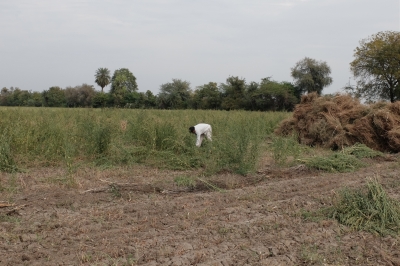 This pile is coriander waiting to be threshed but the green prolific plant is a rampant weed. Bathli is like spinach when young and green and edible. It has taken over the field as we didn’t weed it at the right time and so now it has to be dealt with before the seeds fall. It took two men more than a week to cut it and dry it in small piles. It will be burned after the wheat has been harvested and the risk of fire loss removed.
This pile is coriander waiting to be threshed but the green prolific plant is a rampant weed. Bathli is like spinach when young and green and edible. It has taken over the field as we didn’t weed it at the right time and so now it has to be dealt with before the seeds fall. It took two men more than a week to cut it and dry it in small piles. It will be burned after the wheat has been harvested and the risk of fire loss removed.
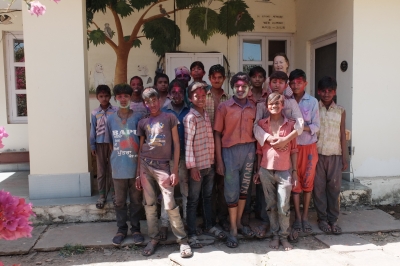 Holi this year was on 24th March. Here’s a group of boys who turned up to greet us and get a chocolate chip biscuit.
Holi this year was on 24th March. Here’s a group of boys who turned up to greet us and get a chocolate chip biscuit.
We are going to try growing moong dal as there is a national shortage and the price is good but we want to grow it without pesticide and will have to protect it from nilgai, stray cows, and monkeys as it will be like an oasis in a parched landscape. By the end of March we had sown it and watered it and were preparing to add a soil conditioner called RECHARGE.
By the end of the month the heritage wheat had been cut and was drying in bundles. The wheat we have grown for the Indian Tobacco Company (ITC) will be combined soon and the rest of the wheat will be hand cut by a family of migrant labourers from Madhya Pradesh who appeared asking for work. The men came around to fix work and then went back to collect their families. Without land and with no other income they need such agricultural work to survive; no government handouts for them.
On the Farm - February ’16
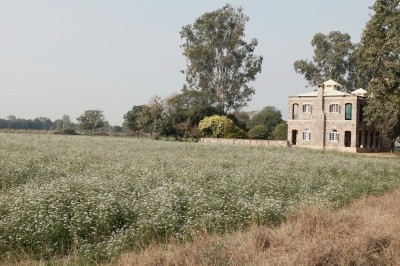 At the beginning of February the coriander was in full bloom and buzzing with apis florea - ‘Little Bees’. By the end of the month the mustard and coriander had been cut by hand and was drying in the fields.
At the beginning of February the coriander was in full bloom and buzzing with apis florea - ‘Little Bees’. By the end of the month the mustard and coriander had been cut by hand and was drying in the fields.
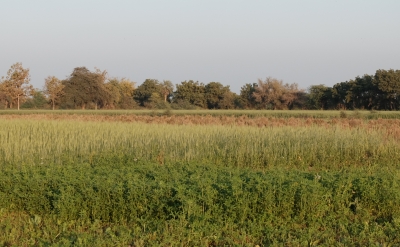 This is a view taken at the end of the month across the berseem which is cut daily for the cows, to the heritage wheat C306 which is tall and silky. Behind the wheat is coriander cut and drying and in the background green commercial wheat HI-1544, which is being watered for the third time from the borewells.
This is a view taken at the end of the month across the berseem which is cut daily for the cows, to the heritage wheat C306 which is tall and silky. Behind the wheat is coriander cut and drying and in the background green commercial wheat HI-1544, which is being watered for the third time from the borewells.
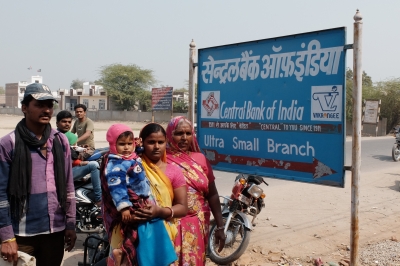 On 17th February I was asked by these three illiterate farm residents to take them to open bank accounts at a nearby ultra small branch of the Central Bank of India. The branch is in a small shuttered shop and comprises an ATM in a cubicle like a London telephone box and an area the equivalent of seven more kiosks. It was operated by a young man behind a screen with a laptop, a cash drawer, a pile of ledgers and a machine that registered digital finger prints of all ten digits. He filled the forms in and they affixed their thumb impressions. Once the account is activated they can pay-in and withdraw using the digital recognition device. They will have to deposit Rs.500 (5-6 GBP) when they collect their passbooks in ten days’ time. The current government is striving to open bank accounts for all residents so that cash transfers can go straight into bank accounts. It is worth their while paying the banks to run this system as it will save crores of rupees which are ususally misappropriated.
On 17th February I was asked by these three illiterate farm residents to take them to open bank accounts at a nearby ultra small branch of the Central Bank of India. The branch is in a small shuttered shop and comprises an ATM in a cubicle like a London telephone box and an area the equivalent of seven more kiosks. It was operated by a young man behind a screen with a laptop, a cash drawer, a pile of ledgers and a machine that registered digital finger prints of all ten digits. He filled the forms in and they affixed their thumb impressions. Once the account is activated they can pay-in and withdraw using the digital recognition device. They will have to deposit Rs.500 (5-6 GBP) when they collect their passbooks in ten days’ time. The current government is striving to open bank accounts for all residents so that cash transfers can go straight into bank accounts. It is worth their while paying the banks to run this system as it will save crores of rupees which are ususally misappropriated.
On the Farm - January ’16
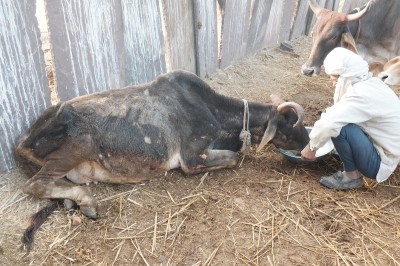 The most memorable, sad event on the farm in January 2016 marked the end of an era. Mun-Mun, our iconic one-horned matriarch died aged 23.
The most memorable, sad event on the farm in January 2016 marked the end of an era. Mun-Mun, our iconic one-horned matriarch died aged 23.
January was unusually warm with clear blue skies and temperatures in the high twenties until the third week when the wind changed to the north and night temperatures dropped as low as 7oC. That’s as cold as it gets.
On Sunday 17th Mun-Mun could barely stand but was revived with hot brown sugar (gur) in water. You can see bare patches on her skin where it seems to have stopped rejuvenating.
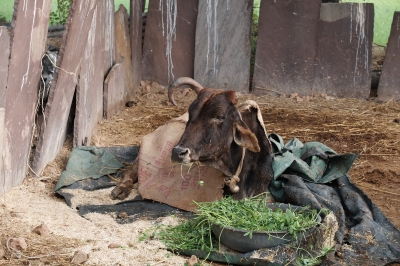
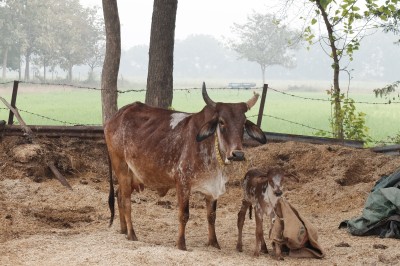
On the 19th, Mun-Mun's latest grand-daughter was born to Meera, one of her 12 children, just prior to a heavy shower of rain. Mun-Mun barely survived but with the warmth of the sun externally and hot sugar internally she was sitting up in bed eating berseem at 3.00pm. She died on the night of the 20th surrounded by her surviving daughters and grand-daughters. Her first daughter had died of old age two years previously.
Mun-Mun had a very sweet nature and would let you handle her new born calves but none of the current cows are as trusting. She is sorely missed.
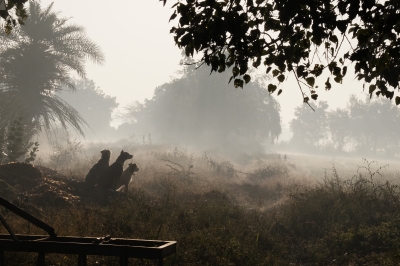
The final photo this month is of the dogs enjoying a misty sunrise.

